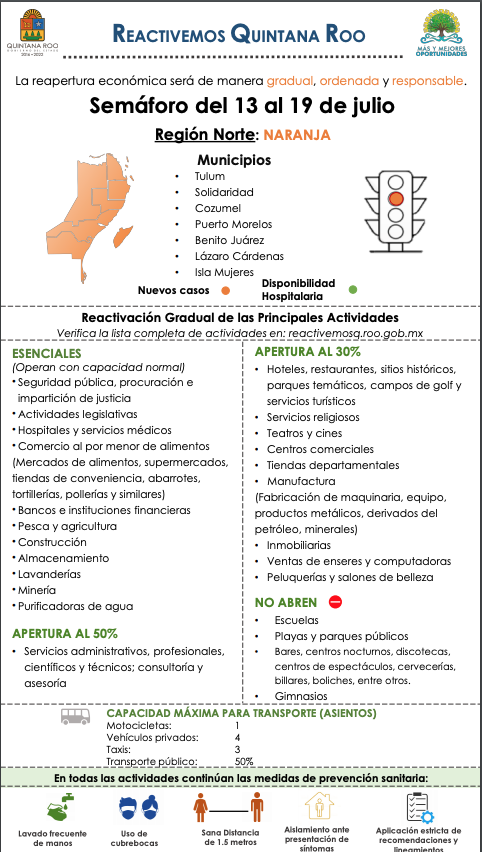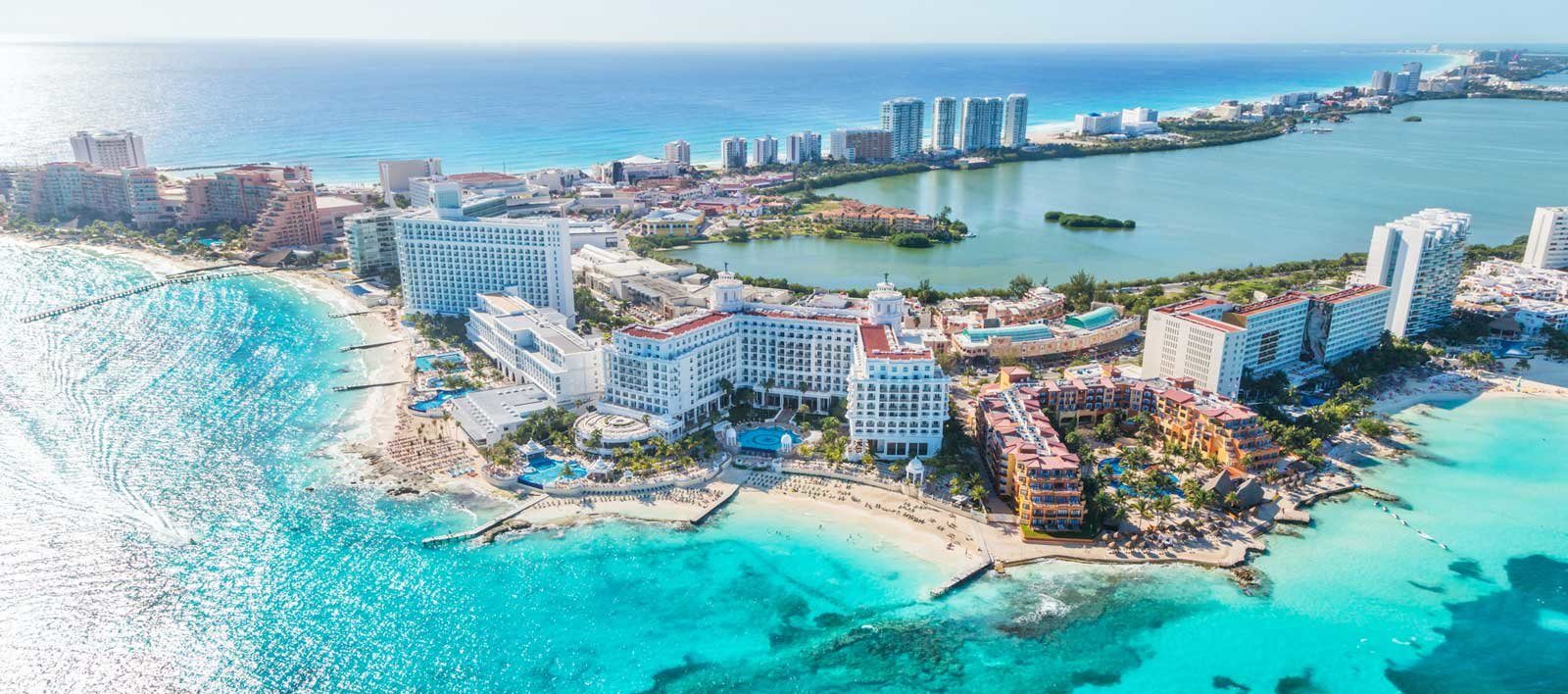Cancun is a vacation and tourist destination in Mexico located on the northeastern tip of the Yucatan Peninsula. It is located in the Mexican state of Quintana Roo. Since the reopening of Quintana Roo to tourists many people ask if it is safe to visit Cancun.
The Quintana Roo government had taken early steps to slow the spread of COVID-19 by shutting down all resorts, tours and activities in March 2020.
After months of carefully monitoring the situation, the Quintana Roo government began establishing new required safety and sanitation protocols for all businesses in the state. All businesses that wished to reopen are required to provide training to staff and get certification from the government that they have protocols and procedures in place to help prevent the spread of COVID-19.
As long as tourists and workers in the resort areas continue to adhere to the established guidelines it is safe to visit Cancun for American Tourists.
On June 8, 2020 the Quintana Roo began a phased approach to reopening tourist destinations in the state, including Cancun.
The reopening plan utilizes a traffic light type of system to determine the risk levels associated with the COVID-19 pandemic in the area. Each week the traffic light system is updated. Based on the level, certain businesses are allowed to open with limitations as long as safety and sanitation protocols and measures are in place. As long as businesses and workers adhere to these guidelines it is just safe to visit Cancun as any other destination.
- Social Distancing: Social Distancing is required whenever possible. People are required to maintain 1.5 meters (5 feet) of distancing between themselves and others.
- Temperature Checks: Remote temperature instruments, such as infrared thermometers, are being utilized to take the temperature of tourist and workers. When visiting, you should expect that your temperature will be taken at the airport upon arrival, upon arrival at your hotel or resort, when entering restaurants, shops and other businesses.
- Rigorous Hand Washing: Employees at all business must wash their hands or disinfect with sanitizer at least once every 30 minutes or when necessary. No unnecessary physical contact is allowed between staff and visitors (hand shaking, greeting, etc).
- Symptom Posters: Posters on basic symptoms of infections are displayed in public areas frequented by visitors and tourists. Symptoms include respiratory: cough, fever, headache, sore throat, runny nose and red eyes.
- Footwear Disinfection Mats: Inside the entrance of all open businesses. Visitors must walk through mats that contain disinfectants.
- Hand Sanitizing Solutions: Alcohol-based hand sanitizer dispensers must be available inside all businesses. The sanitizer must contain at least 70% alcohol.
- Face Masks: Face masks must be worn at all times by staff. Visitors may also be required to wear face masks when inside a business. Masks should be available to any visitors that do not already have them.
- Basic Sanitary Preventive Measures: Visitors and guests are encouraged to avoid touching their faces, in particularly eyes, nose, and mouth.
- Social Distancing Signage and Floor Markings: Safe distance signage is in place in all areas where staff or visitors may be waiting in lines. The markers will be visible on the floor or other obvious area.
- Physical Greetings are Prohibited: Physical greetings of visitors or staff is prohibited, such as handshakes or any other greeting involving physical contact.
- Furniture Arrangement: Any furniture located in common areas must be rearranged to accommodate safe distancing requirements of 1.5 meters. This includes areas such as hallways, lobby areas, bars, lounges, poolside, dining rooms and all other public areas of resorts, restaurants and businesses.
- Elevators: Staff and visitors will not share elevators unless it is absolutely necessary. Guests are encouraged to only enter elevators with immediate family members. Elevator usage should be limited to a maximum of two unrelated people.
- Digital Information Sharing: Digital information sharing is encouraged whenever possible, such as with restaurant menus, purchase receipts and other times when visitors may need information.
- Avoid Printed Items: Printed items, including magazine, newspapers and brochures should be avoided in all areas.
- Restrooms: Water, soap, paper towels and sanitary paper must be available at all times in restrooms used by visitors and staff. Restrooms for both visitors and staff must have automatic paper towel dispensers for drying hands that avoid physical contact the dispensers. Posters and signage detailing proper hand washing and sanitation must be visible in restrooms.
Additional measures are required to protect the health and safety of the employees of tourism related businesses. Staff members in tourism related businesses must take at least 10 hours of safety and sanitation courses.
Sanitizer, personal protection equipment such as masks and shields, nitrile gloves and other safety equipment are made available to all staff. Body temperatures are taken for each staff member at the start of each shift.
All establishments, including hotels, resorts, restaurants, stores, shopping centers, lounges and bars are required to operate at a limited capacity. The capacity level is determined by the traffic light safety system.
For the purposes of the traffic light health and safety system, the state of Quintana Roo is divided into northern and southern areas. Major tourist destinations including Cancun, Tulum, Isla Mujueres, Puerto Morelos, Cozumel and Playa Del Carmen are located in the Northern Area.
As of the week of July 13th to July 19th, the Northern Region is currently operating at level orange (naranja).
This allows essential business such as grocery stores, government offices, hospitals, banks and other financial institutions, construction and other essential businesses to operate as usual.
Under the orange guidelines, hotels and resorts are limited to at most 30% guest capacity.
What this means is that if a resort hotel has 300 rooms, only 90 rooms can be occupied by guests. This limitation is the same for all restaurants, churches, theaters, shopping centers, hairdressers and beauty salons, and other tourist services.
The list of items that remains closed includes schools, public parks and beaches, bars & nightclubs and gyms.
Public transportation such as local buses can not have more than 50% capacity and all persons on the bus must where face masks or shields. Additionally, no more than 4 people are allowed in private vehicles.
Taxis are not allowed to carry more than 3 passengers at a time. So if you’re traveling with a large family you may need to split up and take separate taxis when venturing outside your hotel or resort.


